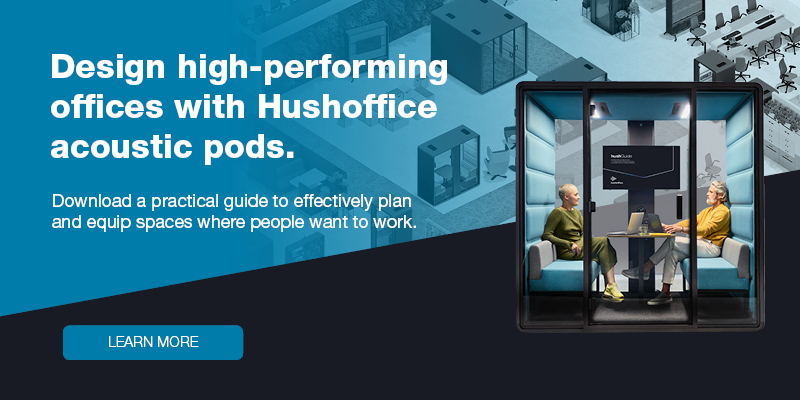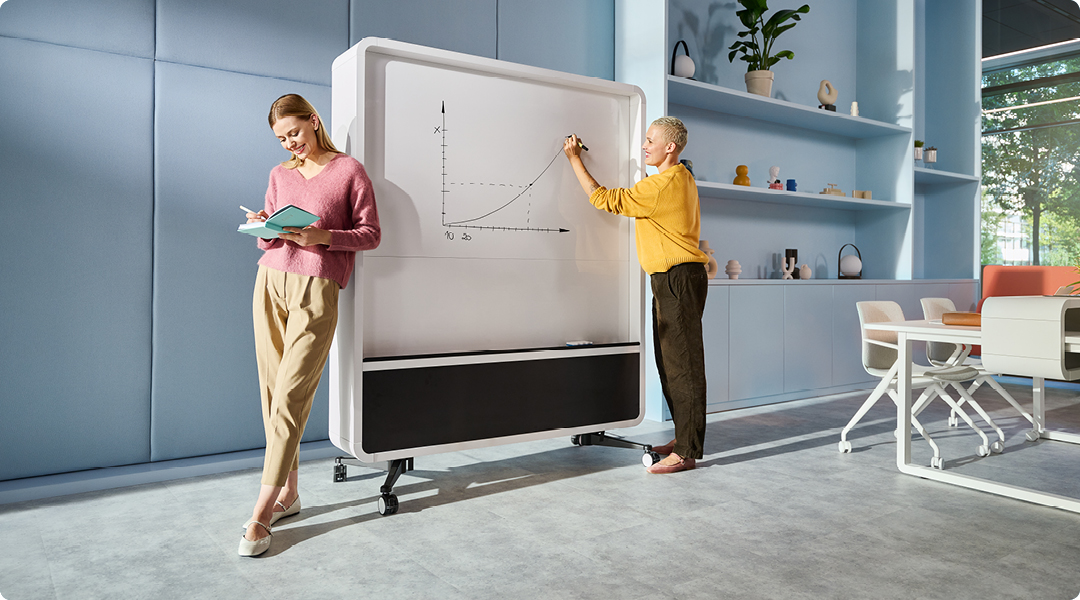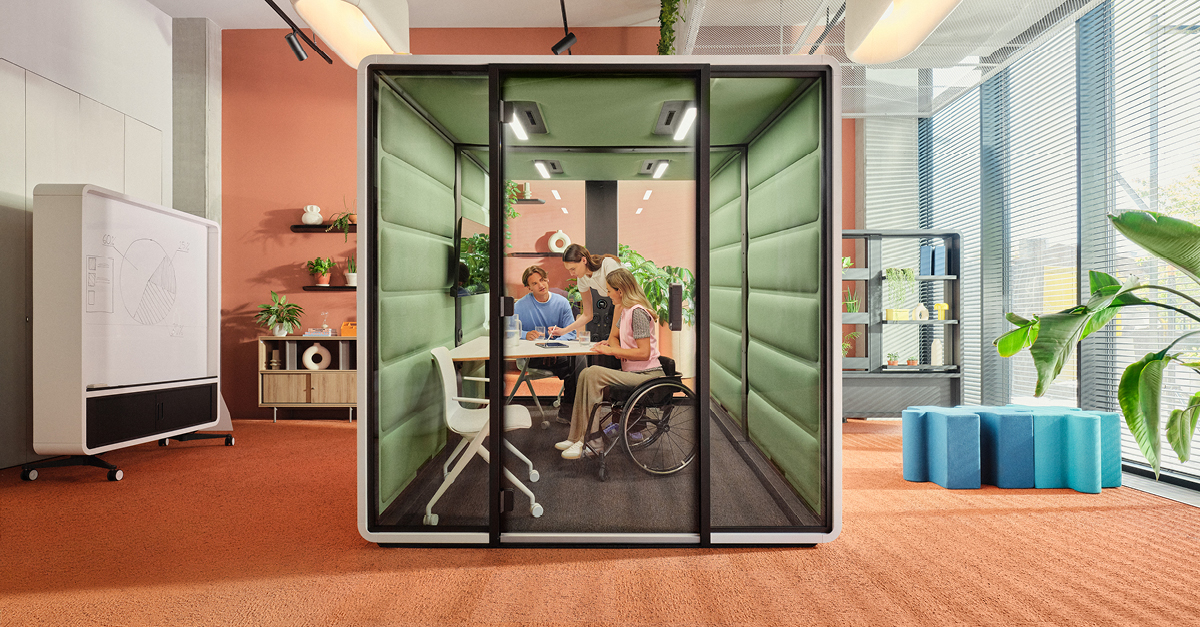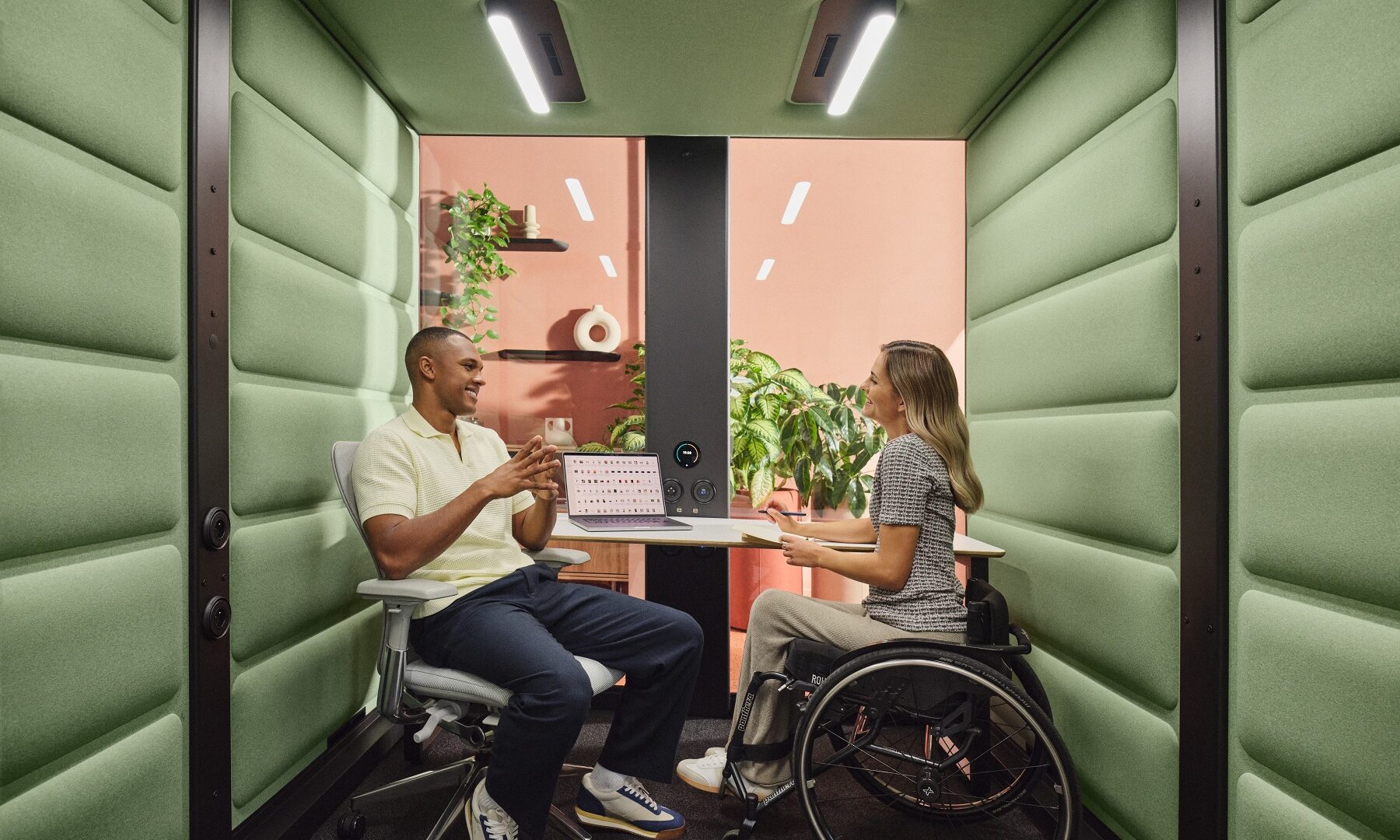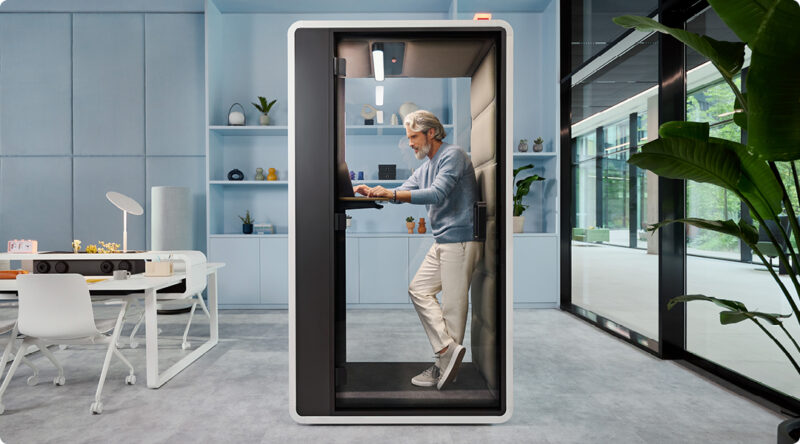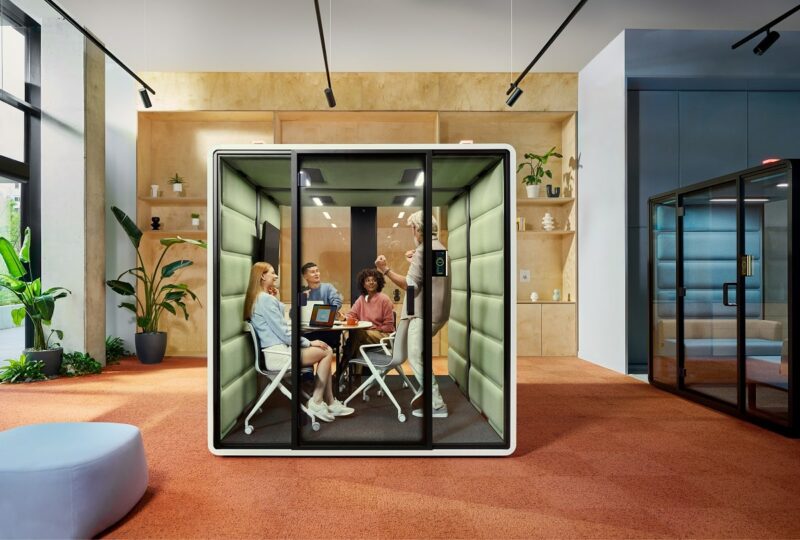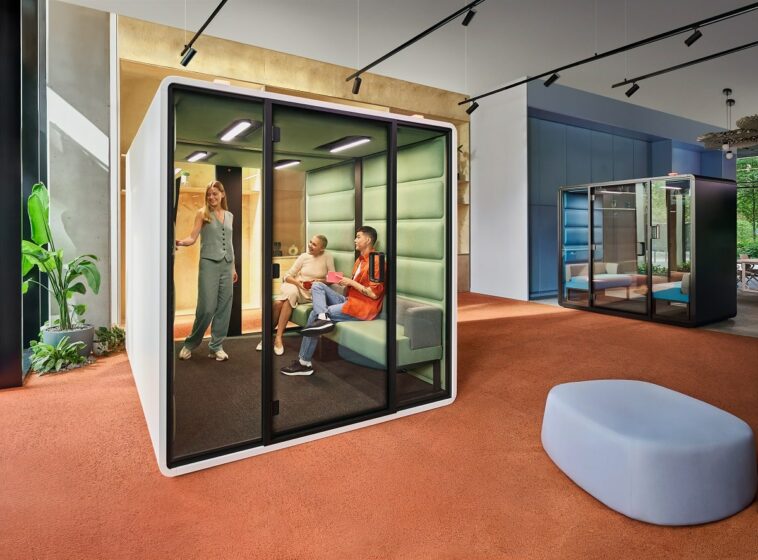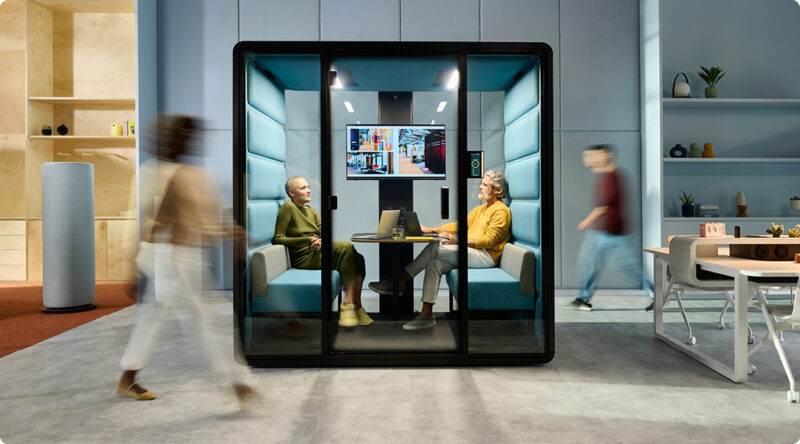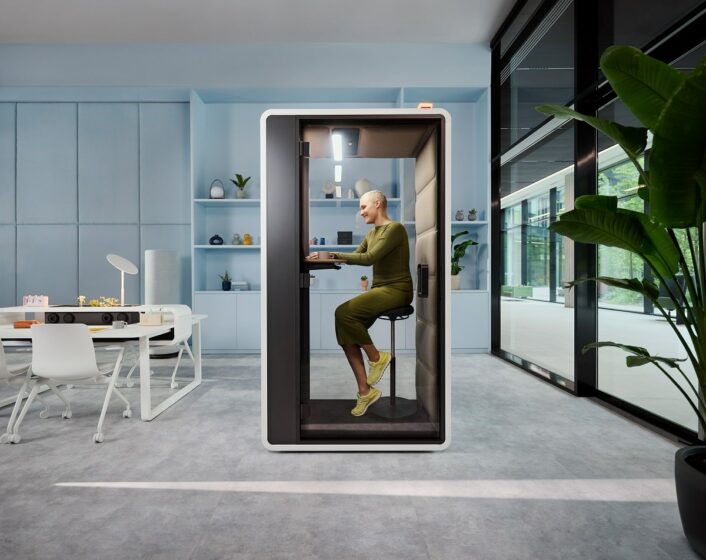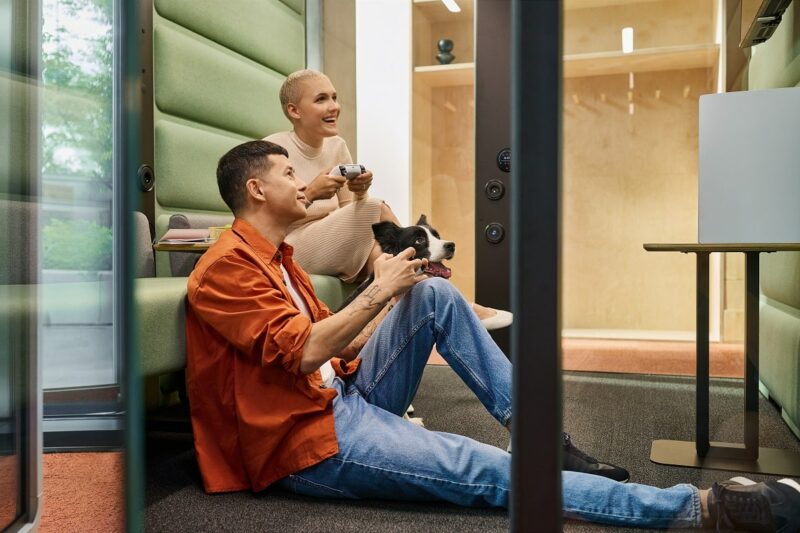Workplaces that scale: future-proofed office design for startups
- Posted on: 1 July 2025
- By: Hushoffice Team
Innovation moves fast and decision-making is daily for teams at the very beginning. In this unique phase, the physical environment needs to be responsive on the daily yet agile long-term. How can every square meter earn its keep?
Future-proofed office design for startups – tl;dr
- A startup’s workplace should be designed to handle uncertainty as a normal part of business. Unlike mature companies with predictable workflows, teams just starting out pivot often. Every fixture, from a single Hushoffice booth to a modular desk cluster, should be easy to relocate or repurpose. This approach prevents wasted square meters and allows teams to reconfigure the office in hours rather than weeks.
- Acoustic quality is not just about comfort. It directly affects morale and decision-making speed. And in small, busy startup offices, background noise builds up fast. This is especially true with hybrid calls happening alongside team huddles. Combining soft finishes like rugs and curtains with built-in quiet zones like booths is ideal — it creates a sonically sound landscape where people feel calmer and think more clearly. This, in turn, paves the way for sharper discussions and faster resolutions.
- The most effective startup offices guide behavior intuitively without heavy policies or rules or intense thought on the employee’s part. Subtle design cues work best. Changing ceiling heights. Varied lighting. Blends of greenery. The details signal when a zone is for quiet focus versus open collaboration. Such spatial storytelling helps teams self-organize naturally throughout the day, reducing friction and freeing leaders to focus on growing the business rather than policing how the office is used.
Traditional or virtual office for a startup?
Going fully remote might seem like the obvious cost-saver early on. But for many startups, it can actually slow things down. This is particularly true for anyone deep in product development, as one of countless examples. There’s just something about being in the same room when you’re trying to solve a tricky bug or think through a sophisticated feature. This is why a hybrid setup, with a small but well-equipped furniture array, meets the better balance for many. You really don’t need a big office at all, but a space that smoothens daily interactions without compromising independent focus. Flexibility is the essential aspect
-says Mateusz Barczyk, Senior Brand Manager, Hushoffice.
Startups operating remote-first models often report slower problem-solving and longer time-to-market compared to those with some in-person overlap. Surprising? More than 70% of small, high-growth companies say a flexible physical hub helps maintain team cohesion better than fully remote setups.
Design your space around the most frequent, business-critical activities.
Product-focused teams might need whiteboards, user testing setups, and quick stand-ups. Sales-heavy teams might need private call booths, CRM-integrated desks, or war rooms for strategy sprints. Content groups might need quiet editing areas like a 4-person booth.
Startups pivot often. Their office should, too.
Mobile partitions and chairs. Fold-down screens. Wheeled whiteboards. The right flexible pieces can turn a coffee spot into a pitch space in minutes. Ultimately, switching tasks should feel less like shifting gears and more like sliding between tracks.
Modular furniture is integral.
Height-adjustable desks. Mobile storage units. Reconfigurable seating. These pieces let teams rearrange when a new hire joins, a cross-team project spins up, or a hackathon needs more space. Pieces that 1-2 people can safely move are ideal, for minimized downtime and setup effort.
Collaboration and quietude must be integrated.
Early-stage startups often gravitate toward open layouts because they seem like the fastest way to encourage back-and-forth and energy. But without thoughtful boundaries like partitions and pods, the openness can quickly backfire. Pods are so helpful because they are islands of perfect privacy.
Different types of work demand different kinds of space. Smart office designers carve out distinct zones for each type. Quiet, heads-down areas for undivided concentration. Nooks for flowing solo work. Lively corners where teams can bounce ideas around and hash things out together. 4-person booths like hushFree for small, private gatherings. And cues in the space help guide the movement between every space, like softer lighting, planter walls, or textured acoustic panels. Such details can signal what each zone is for, so the space itself gently guides behavior without needing a rulebook or too much thought
– says Mateusz Barczyk, Senior Brand Manager, Hushoffice.
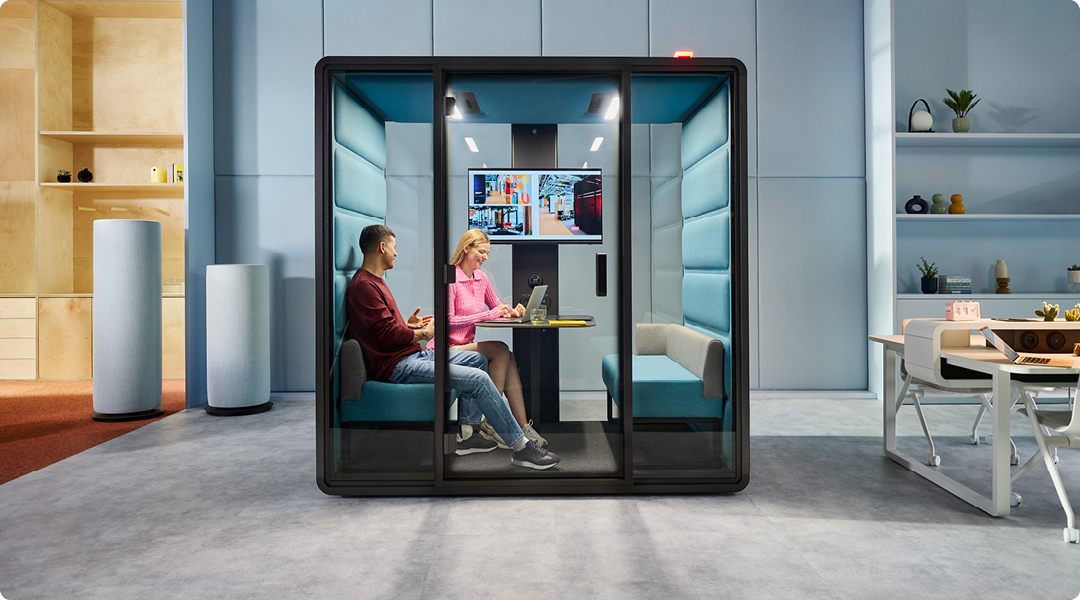
So is an open office plan the ideal layout for startups?
Open plans support visibility and fast communication. But only when noise and distractions are managed. Consider semi-open plans with distinct “neighborhoods” for different teams. These neighborhoods can be clearly delineated by movable space dividers and pods for the most natural wayfinding.
Make brainstorming zones casual but purposeful.
Soft seating in circular arrangements. Writable walls or tables. Quick access to relevant prototypes or screens. Natural light, bold colors, and playful elements — like creative prompts or interesting materials — also help keep the feeling right for ideation.
Ordered chaos promotes creativity.
Allow for a bit of organized mess. Shelves with materials, spaces to pin up inspiration, or a “project wall” whiteboard like hushWall for ongoing sketches and plans. Personalization helps as well. Try giving teams freedom to make spaces their own so they feel ownership over the creative process.
The typical office startup acoustic problem: noisiness.
Small offices can amplify sound, with hard surfaces bouncing around background noise. Without intervention, this will more than likely lead to burnout, hurting performance. Acoustic ceiling panels, wall baffles, and soft textiles like rugs, curtains, and upholstery all absorb the excess noise.
In too many small offices, sound just kind of hangs in the air. It may ricochet off bare walls and hardwood floors with nowhere to go. So one person’s video call turns into noise for everyone else. Without acoustic treatments, the minutest sounds will indeed layer up until it’s hard to think clearly. In shared spaces like coworking benches, this can produce a constant tension on top of general anxiety. People may begin to hesitate taking a call, or they may even hold back from asking a quick question. Acoustic panels and Class A pods like hushFree go a long way in giving people what they need, which is a choice between quiet and connection
– says Mateusz Barczyk, Senior Brand Manager, Hushoffice.
Acoustic booths are the ultimate privacy solution.
Pods are pop-up silence amidst buzz. They’re apt for sales calls, investor check-ins, or interviews — any task requiring full attention. Hushoffice booths in particular offer ventilation, proper lighting, and power outlets, with spacious models like hushFree.Access.L that are wheelchair-accessible
Cooperation thrives on impromptu discussions.
This means offering places for quick one-on-ones, larger team syncs, and “in-between” moments like hallway chats or lunch conversations. Try to create pathways that lead people to bump into each other, as the physical flow of the office can make a big difference.
A coffee spot can be more impactful than a formal boardroom.
Informal meeting areas like sofas and kitchen islands make for pressure-free settings. Here, relaxed discussion happens organically, often solving roadblocks and hangups. These areas should feel casual and comfortable, signaling it’s okay to take a break and talk freely.
Cross-departmental collaboration is the name of the game.
Transparent boards or digital screens in shared zones can surface each team’s current focus to others. Similarly, a roadmap wall or cross-functional planning board gives visibility, inviting collaboration. Occasional hot desking across departments also helps by bridging gaps, reducing silos.
Consider ADA acoustic booths for the sensory-sensitive.
For the neurodivergent or hearing-impaired, these are sanctuaries from overstimulation. Pick one that accommodates mobility aids and complies with ADA standards, (wider doorways, lower handle placement). Check out hushFree.Access.M or hushFree.Access.L for guaranteed speech privacy.
Hushoffice booths meet the distinct challenges startups face in office spaces.
Designing an office that actually supports the way a startup works, without wasting space or budget, isn’t easy. From noise issues to inflexible layouts, pesky problems can get in the way. But because they are so fundamentally functional, booths address many of these problems.
Overbuilding for an uncertain future…
Startups can overestimate how much space they’ll need, signing long leases or building out large offices that sit half-empty. The best approach is to start small and design for scalability. Modular layouts and flexible solutions like acoustic booths let you add private meeting or focus spaces as needed.
Designing only for current team size…
It’s easy to plan an office that fits today’s headcount. But growth can come fast. A space that works now may become cramped and chaotic later. Indeed, modular furniture and reconfigurable layouts tend to work best as they can evolve with your team.
Poor acoustic control in small offices…
Adding acoustic treatments helps absorb sound, while booths provide the contained space for quiet, focus-intensive tasks or noise-sensitive calls.
Lack of privacy for classified or sensitive calls…
Open layouts offer visibility but little discretion. Call pods like hushFree.S are instantly available sound-insulated rooms for private moments. No construction, no scheduling delays; sheer plug-and-play confidentiality.
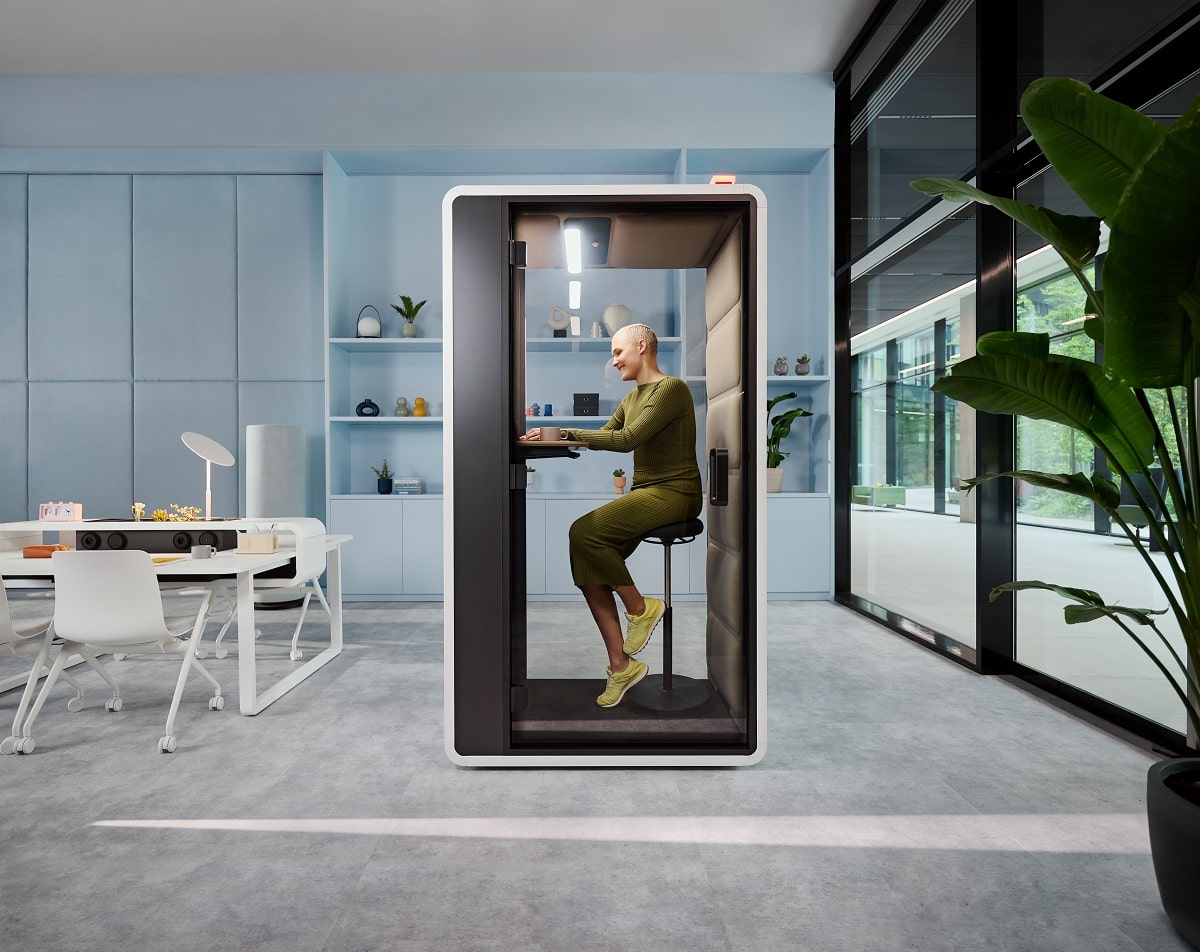
Underutilized or mismatched furniture…
Bulky furniture is spatially limiting, making it difficult to respond to changing priorities, team sizes, or new projects. Go for lightweight, movable pieces that teams can reconfigure. The space should be able to change as fast as the company does without needing a facilities team every time.
A startup’s office doesn’t need to be large or extravagant. Instead, it really needs to work intelligently for the team every single day. It should scale smoothly as headcount grows, provide calm spaces for intensive work, and encourage spontaneous discussions when collaboration is key. When the fundamentals are well-designed — flexible layouts, effective acoustic control, and dedicated zones like Hushoffice booths — the workspace actively supports a company’s pace of change and helps teams stay connected
– says Mateusz Barczyk, Senior Brand Manager, Hushoffice.
Office design for start-ups – tl;dr
- A startup’s workplace should be designed to handle uncertainty as a normal part of business. Unlike mature companies with predictable workflows, teams just starting out pivot often. Every fixture, from a single Hushoffice booth to a modular desk cluster, should be easy to relocate or repurpose. This approach prevents wasted square meters and allows teams to reconfigure the office in hours rather than weeks.
- Acoustic quality is not just about comfort. It directly affects morale and decision-making speed. And in small, busy startup offices, background noise builds up fast. This is especially true with hybrid calls happening alongside team huddles. Combining soft finishes like rugs and curtains with built-in quiet zones like booths is ideal — it creates a sonically sound landscape where people feel calmer and think more clearly. This, in turn, paves the way for sharper discussions and faster resolutions.
- The most effective startup offices guide behavior intuitively without heavy policies or rules or intense thought on the employee’s part. Subtle design cues work best. Changing ceiling heights. Varied lighting. Blends of greenery. The details signal when a zone is for quiet focus versus open collaboration. Such spatial storytelling helps teams self-organize naturally throughout the day, reducing friction and freeing leaders to focus on growing the business rather than policing how the office is used.
Office design for start-ups – frequently asked questions
What’s the biggest mistake startups make when setting up an office?
Many overestimate how much space they’ll need right away or lock themselves into rigid layouts. This can drain cash and limit agility when priorities inevitably shift. A better approach is to start with a compact, flexible setup. Modular furniture, movable partitions, and plug-and-play Hushoffice booths work brilliantly, allowing the workspace to grow or shrink as the team evolves, without costly renovations.
How do acoustic office booths add value beyond just providing privacy?
Hushoffice booths don’t just block noise. They create small, acoustically perfect environments that support different types of work on demand. Deep solo focus. Sensitive calls with investors. Quick brainstorming with two or three people. Because they’re self-contained, they reduce the need to build fixed meeting rooms, making your floor plan more versatile and future-proof at minimal cost.
How can a startup office encourage both speed and well-being?
High-growth teams work fast. But burnout is common if the workspace pushes people to be “always on.” The key, as always, is careful balance. Clear zones for quiet, stress-free solo work and well-equipped corners for intense teamwork are best complemented by comfortable informal areas for casual chats and kicking back. Good acoustics, natural light, and personal pods also help maintain this balance daily.

